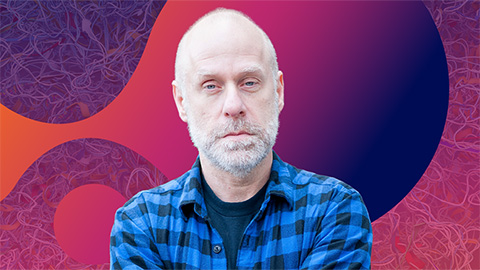Lipid regulation of mitochondria
Mitochondria are dynamic organelles that grow, divide and fuse in most of the human body’s cells; these dynamic membrane processes are critical for mitochondrial health.
Our laboratory studies mitochondrial division and fusion, focusing on three mechanochemical dynamin-related GTPases: Drp1, mitofusin and Opa1. Drp1 is a soluble GTPase that splits the mitochondrial membrane. Mitofusin and Opa1 are integral membrane GTPases that work together to fuse the mitochondrial membranes. Mutations in each of these enzymes lead to human diseases that mainly affect central and peripheral nervous systems.
Mitochondrial division and fusion need to be balanced to maintain functional mitochondrial size, structure and distribution within cells. This dynamic balance is controlled by several layers of mechanisms, including gene expression, post-translational modifications and protein degradation of these GTPases and their binding partners. In addition, mitochondrial phospholipids play important roles in regulation of mitochondrial dynamics.
 Cardiolipin, or CL, in the mitochondrial outer membrane promotes oligomerization of Drp1 to drive mitochondrial division; CL in the inner membrane mediates fusion through heterotypic interactions with Opa1. Hiromi Sesaki et al.Drp1 interacts with two phospholipids, cardiolipin, or CL, and phosphatidic acid, or PA, in the mitochondrial outer membrane, or OM. CL is synthesized in the mitochondrial inner membrane, or IM, and a fraction of CL is transported to the OM. Drp1 is recruited to the mitochondria through its receptor proteins on the surface of mitochondria; binding to CL stimulates Drp1 to assemble into high-order oligomers that function as a division machinery. The machinery is regulated further by PA. Binding to PA restrains the assembled machinery from initiating the constriction of the mitochondrial membranes, likely creating a priming step for mitochondrial division. Binding sites for CL and PA are different in Drp1; therefore, these phospholipids may create different degrees of the regulation through a combination of single or concurrent binding to Drp1.
Cardiolipin, or CL, in the mitochondrial outer membrane promotes oligomerization of Drp1 to drive mitochondrial division; CL in the inner membrane mediates fusion through heterotypic interactions with Opa1. Hiromi Sesaki et al.Drp1 interacts with two phospholipids, cardiolipin, or CL, and phosphatidic acid, or PA, in the mitochondrial outer membrane, or OM. CL is synthesized in the mitochondrial inner membrane, or IM, and a fraction of CL is transported to the OM. Drp1 is recruited to the mitochondria through its receptor proteins on the surface of mitochondria; binding to CL stimulates Drp1 to assemble into high-order oligomers that function as a division machinery. The machinery is regulated further by PA. Binding to PA restrains the assembled machinery from initiating the constriction of the mitochondrial membranes, likely creating a priming step for mitochondrial division. Binding sites for CL and PA are different in Drp1; therefore, these phospholipids may create different degrees of the regulation through a combination of single or concurrent binding to Drp1.
The production of CL and PA is a dynamic process in the OM. As described above, CL is transported to the OM from the IM. This transport may be regulated through dynamic interactions at the intramitochondrial OM-IM contact sites. In the OM, there is a phospholipase D, MitoPLD, which converts CL to PA. Since MitoPLD directly binds Drp1, conversion of stimulatory CL to inhibitory PA may happen locally in the vicinity of the division machinery. PA also is produced in the endoplasmic reticulum, or ER, and imported into the OM through ER-mitochondrial contact sites. Drp1 often divides mitochondria at these sites. Mitochondrial PA levels also may be regulated by this interorganellar interaction.
PA changes the mitochondrial membrane’s biophysical properties and facilitates mitofusion-mediated membrane fusion. Opa1, similar to Drp1, binds CL, and this interaction drives membrane fusion. Therefore, lipid transport and synthesis coupled to intramitochondrial contact site dynamics and interorganellar interactions play key roles in controlling mitochondrial dynamics.
Enjoy reading ASBMB Today?
Become a member to receive the print edition four times a year and the digital edition monthly.
Learn moreGet the latest from ASBMB Today
Enter your email address, and we’ll send you a weekly email with recent articles, interviews and more.
Latest in Science
Science highlights or most popular articles

Mapping proteins, one side chain at a time
Roland Dunbrack Jr. will receive the ASBMB DeLano Award for Computational Biosciences at the ASBMB Annual Meeting, March 7–10, just outside of Washington, D.C.

Exploring the link between lipids and longevity
Meng Wang will present her work on metabolism and aging at the ASBMB Annual Meeting, March 7-10, just outside of Washington, D.C.

Defining a ‘crucial gatekeeper’ of lipid metabolism
George Carman receives the Herbert Tabor Research Award at the ASBMB Annual Meeting, March 7–10, just outside of Washington, D.C.

The science of staying strong
Muscles power every movement, but they also tell the story of aging itself. Scientists are uncovering how strength fades, why some species resist it and what lifestyle and molecular clues could help preserve muscle health for life.

Bacteriophage protein could make queso fresco safer
Researchers characterized the structure and function of PlyP100, a bacteriophage protein that shows promise as a food-safe antimicrobial for preventing Listeria monocytogenes growth in fresh cheeses.

Building the blueprint to block HIV
Wesley Sundquist will present his work on the HIV capsid and revolutionary drug, Lenacapavir, at the ASBMB Annual Meeting, March 7–10, in Maryland.



